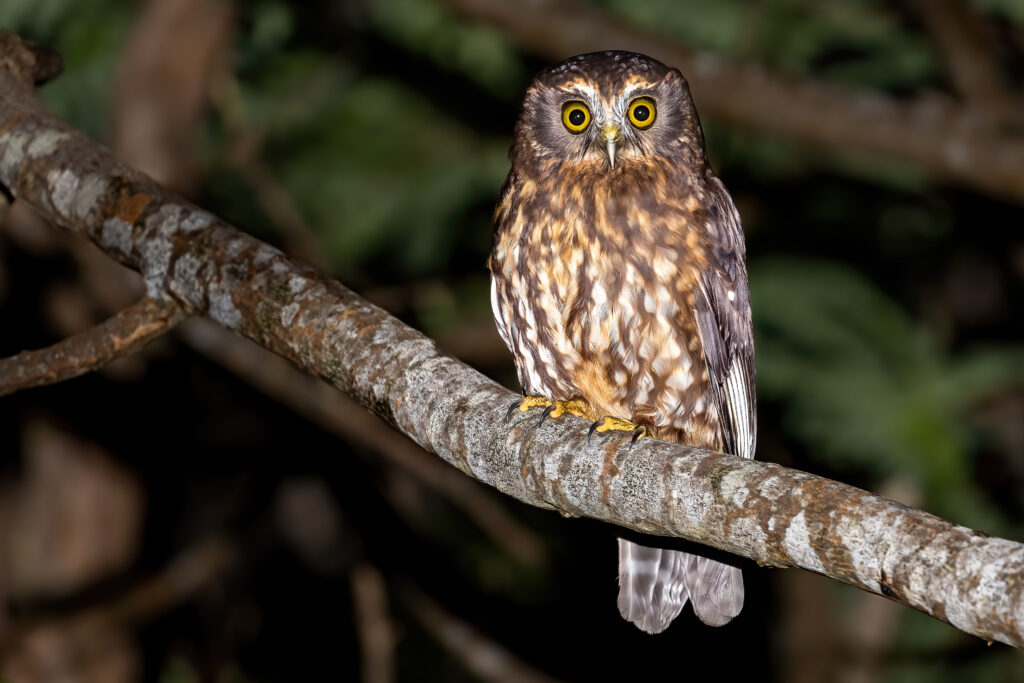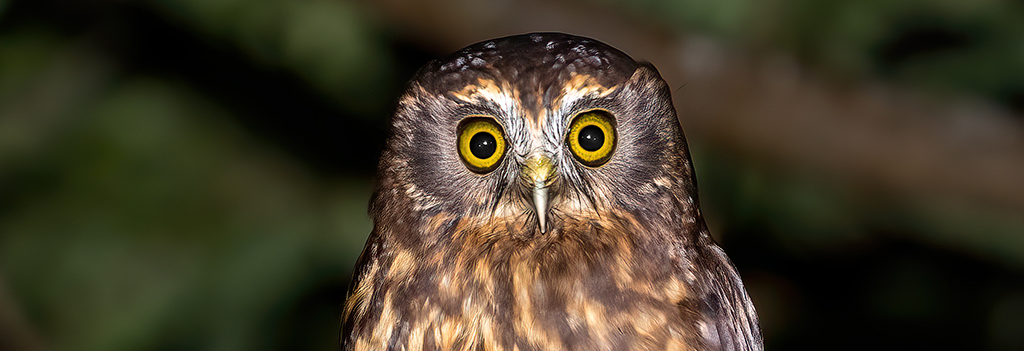Morepork
Originally published on 2021/10/25. Click here to return to the OneWordBirds Archives.
Recently, while leading a birdwatching tour, I casually mentioned to my tour group that I was a fan of birds with one-word names. We had reached a point in the tour where we were becoming familiar and comfortable with one another, and we’d been talking about Dovekie for some reason, so I thought nothing of divulging this piece of personal trivia.
It would be more than fair to suggest that my tour participants didn’t really understand or appreciate what I was rambling about. In retrospect I wonder if they thought I was making an attempt at some sort of offbeat birder humour (wouldn’t have been the first time), and that they simply weren’t in on the joke. Maybe I need to work on my delivery.
I was not joking, of course, but I decided that pursuing the matter further would be fruitless, so I simply changed the subject and we carried on our merry way. We saw Razorbill on that tour – and Dunlin, Merlin, Gadwall, Mallard, and Osprey – but to my participants they were just birds like all the rest.
That brief conversation may not have made a lasting impression on the others, but it got me wondering about the current status of one-word-birds, and reminiscing about that time I indulged my weird obsession and inflicted it on the world. Upon returning home I dived deep into the checklists and taxonomy updates to figure out where things currently stand.
Thusly I am pleased to report to you, reader, that since we last spoke on this topic the number of one-word-birds in the world has remained static at a small-but-noble 146. As the 2021 Clement’s Checklist details a whopping 10,824 species, one-word-birds now represent only 1.35% of the total. An exclusive club, to be sure.
While the number of one-word-birds has not changed, the same cannot be said for the birds themselves, as there have been some additions and some subtractions. One addition in particular caught my eye, both because of the bird’s unusual name and because of the unusual way in which it was added to the list. That bird is the Morepork.

The Morepork is an owl, and I’m willing to wager that while you might not have been sure what you expected a Morepork to be, you probably didn’t expect it to be that. It lives in Australia and New Zealand, and things that live there mostly have funny names to begin with so that makes a certain amount of sense. It belongs to a group of owls called the boobook owls so things don’t get any less ridiculous when we place it in context.
The reason the addition of the Morepork to the one-word-birds club struck me as unusual is that it arose as a result of a species split. Splits happen when ornithologists realize that what they thought was a single species actually consists of two or more groups that are genetically distinct enough to be considered species of their own. This was the case for the Morepork’s parent species, the Southern Boobook.
The problem with splits (from the very-niche perspective of a one-word-bird fanatic) is that they tend to eliminate one-word names in favour of more complex ones. When you think about how a split works, it’s not hard to see why this happens.
Imagine that we have a single species called the Bigbird (an excellent one-word name that surprisingly remains available for use). One day, scientists do a genetic study on Bigbirds and they realize that the Bigbirds in the northern part of their range are distinct from the Bigbirds in the southern part. They split Bigbird into two species and name them Northern Bigbird and Southern Bigbird, which is really the only logical thing to do.
You see, taxonomists are far more concerned with accuracy and logic than they are with fun and frivolity, so they see splits less as an opportunity to create something new and silly and more as a situation which demands the application of order and rationality. This is what makes the Morepork so very special.
I should clarify that Morepork didn’t come completely out of the blue – the unusual moniker already existed as a colloquial name for this owl – but the fact that the powers-that-be opted for the goofiest of all available options when choosing a new name is a considerable and delightful surprise. It gives me hope that one-word-birds aren’t completely doomed to be lost in the ever-evolving taxonomic shuffle. If I had children I would be happy for them.
But, you may be wondering, what the hell does Morepork mean anyway?
It will either please or frustrate you to learn that Morepork means absolutely nothing. It – like boobook, and this owl’s other nickname ‘ruru’ – is simply a nonsense word that is meant to represent the bird’s distinct, two-noted vocalization. It doesn’t even make more sense when you hear the call (below) as it certainly requires some imagination to hear the evocation.
I was prepared to mock the Australians and New Zealanders for hearing a request for meat in the raspy grunt of an owl, but then I remembered that we North Americans literally have a bird called Killdeer who could just as easily be screaming “three cheers” or “come here” or “I’m free” or “it’s me” or literally any other two-syllable phrase so I guess I’ll let them have this one.
At any rate it’s not unusual for bird sounds to inspire bird names – see Chattering Kingfisher or Screaming Piha or Wailing Cisticola as examples – but it’s much less common for the sound itself to become the name in its entirety. I like it, and we should do it more often.
As the self-appointed arbiter of all things one-word-bird, it is my great pleasure to welcome the Morepork to the family. It is not only a deserving member, but proof that good names can come out of taxanomic banality. A hopeful sign for the future. A gift to our children. Well, yours anyway.
Photos:
Top: By JJ Harrison – Own work, CC BY-SA 3.0, https://commons.wikimedia.org/w/index.php?curid=125899981

